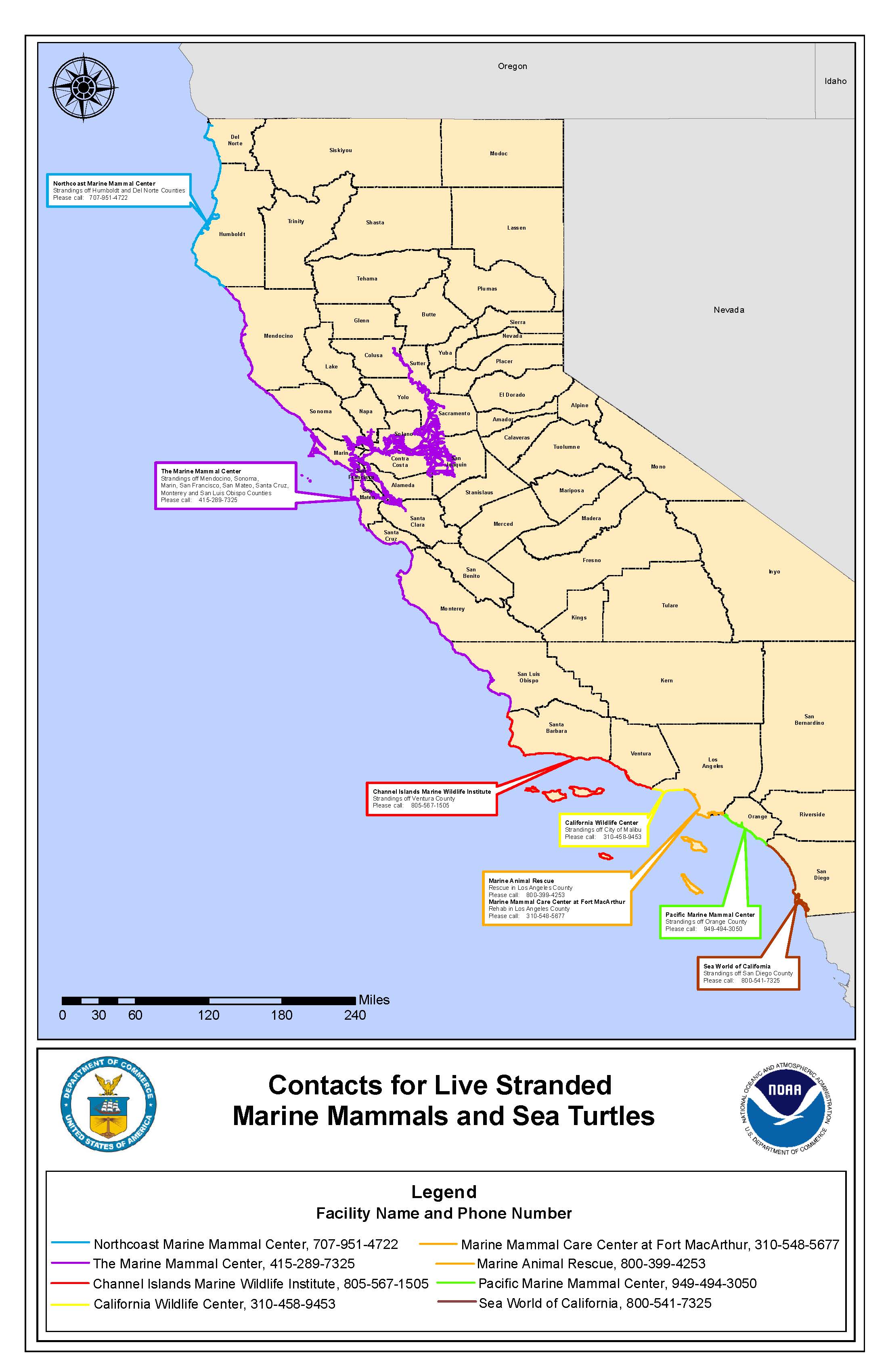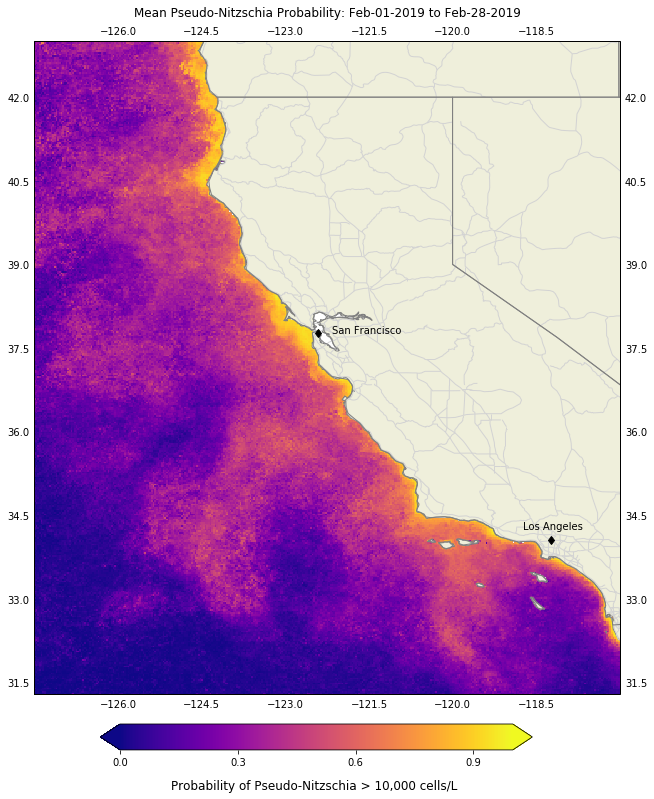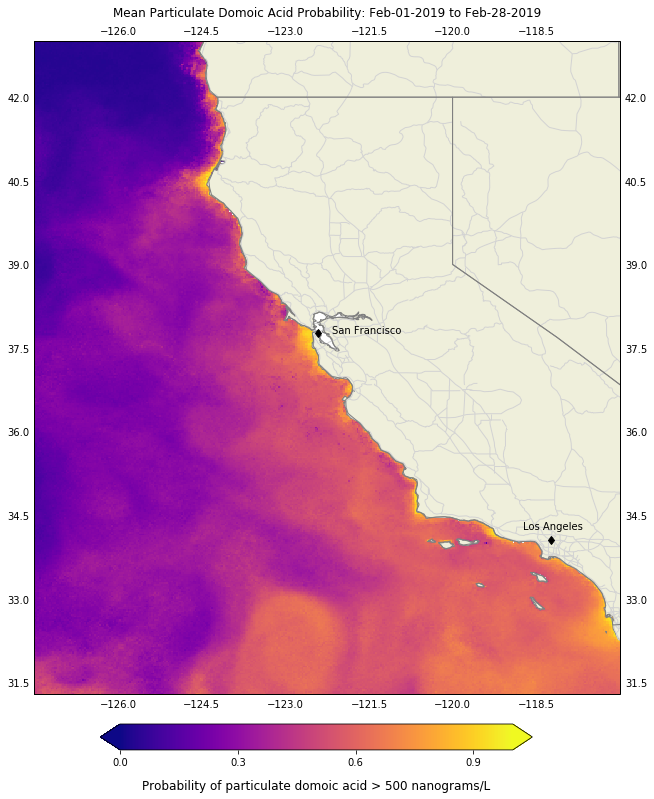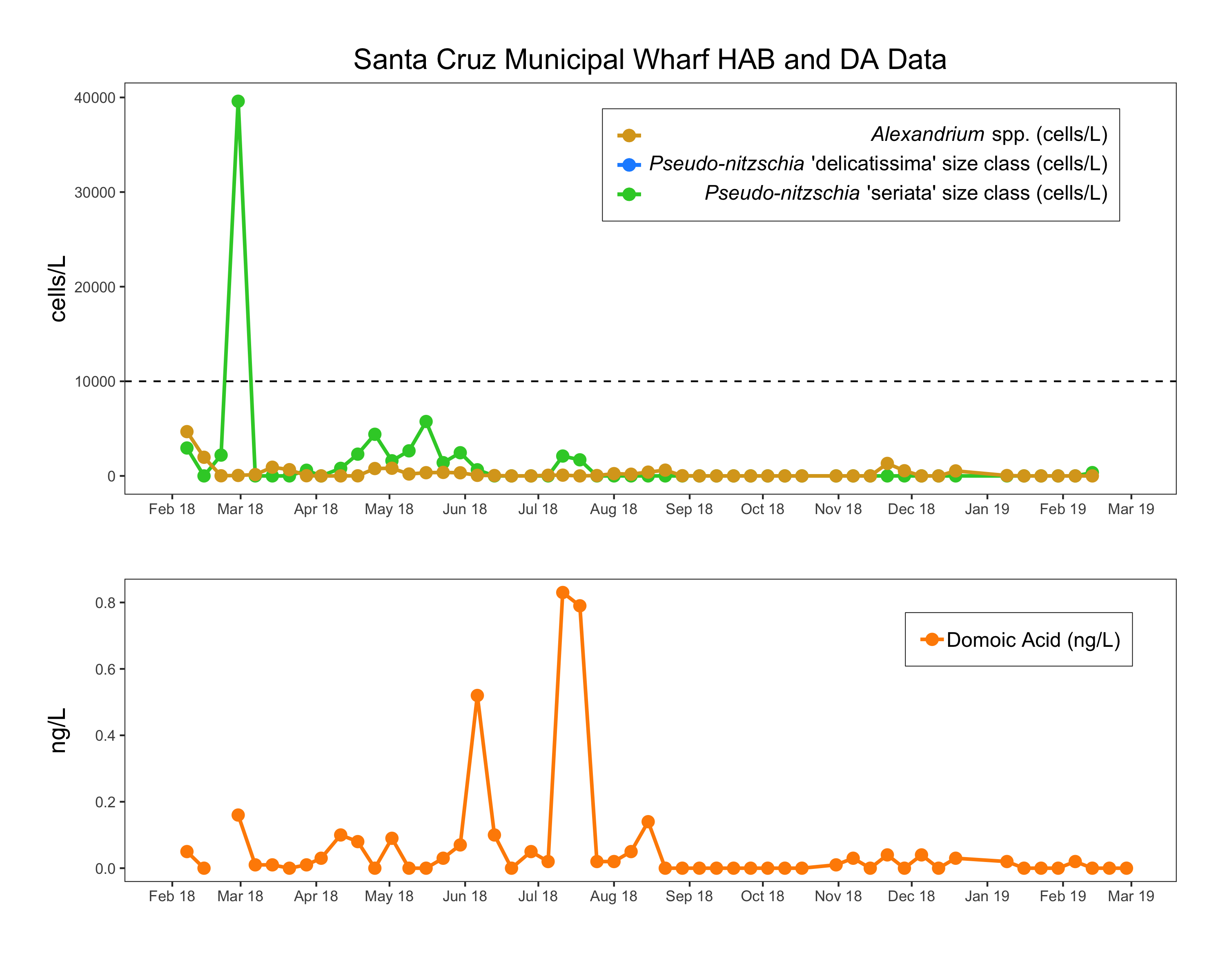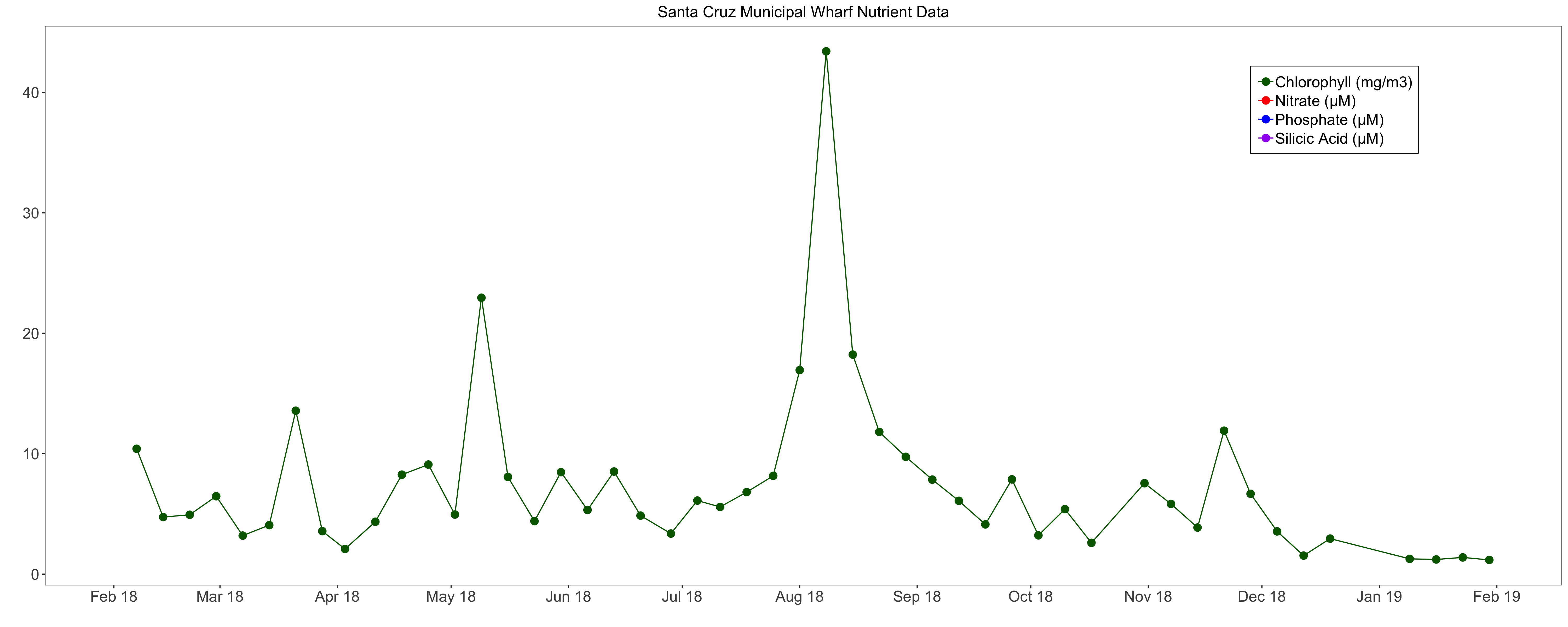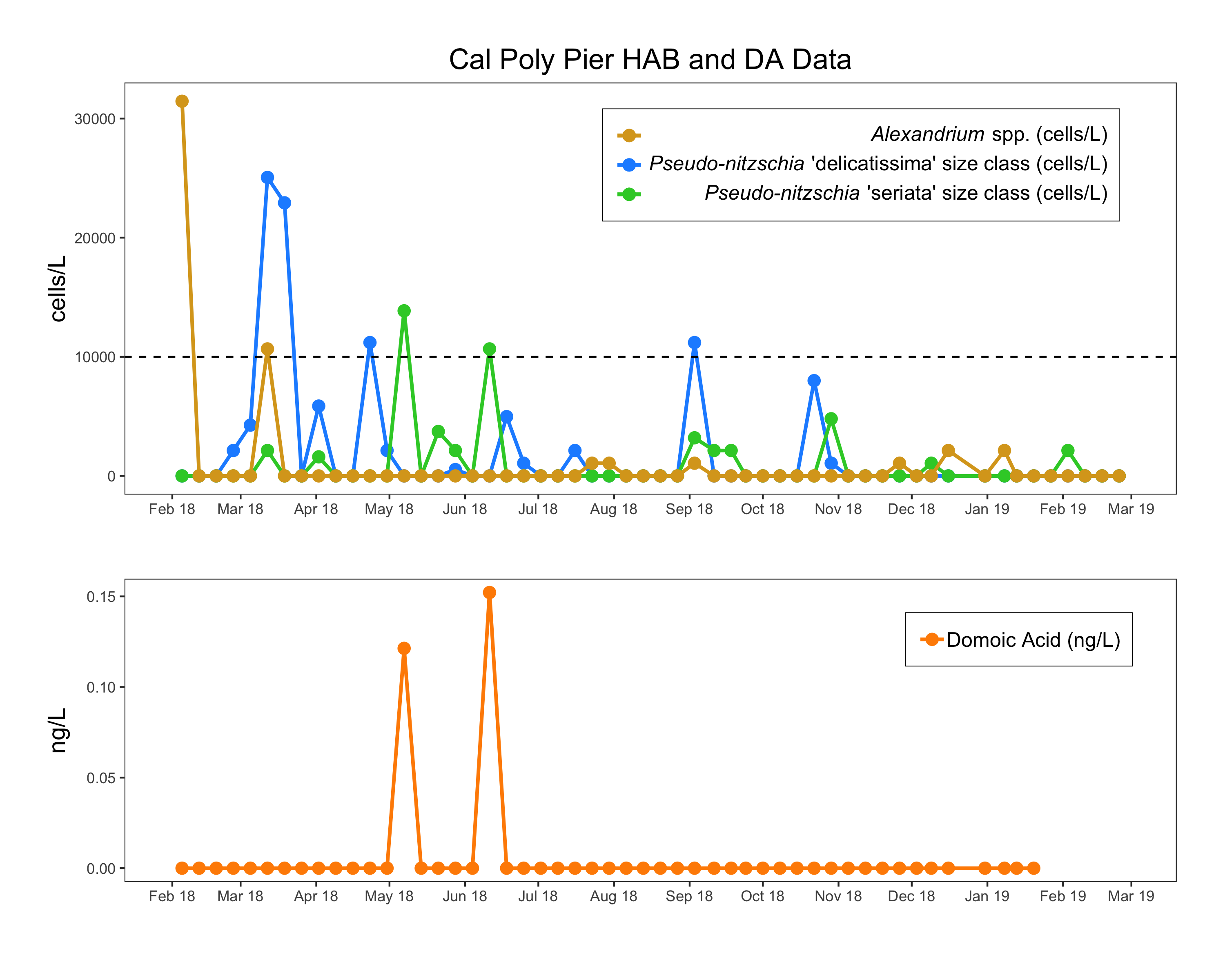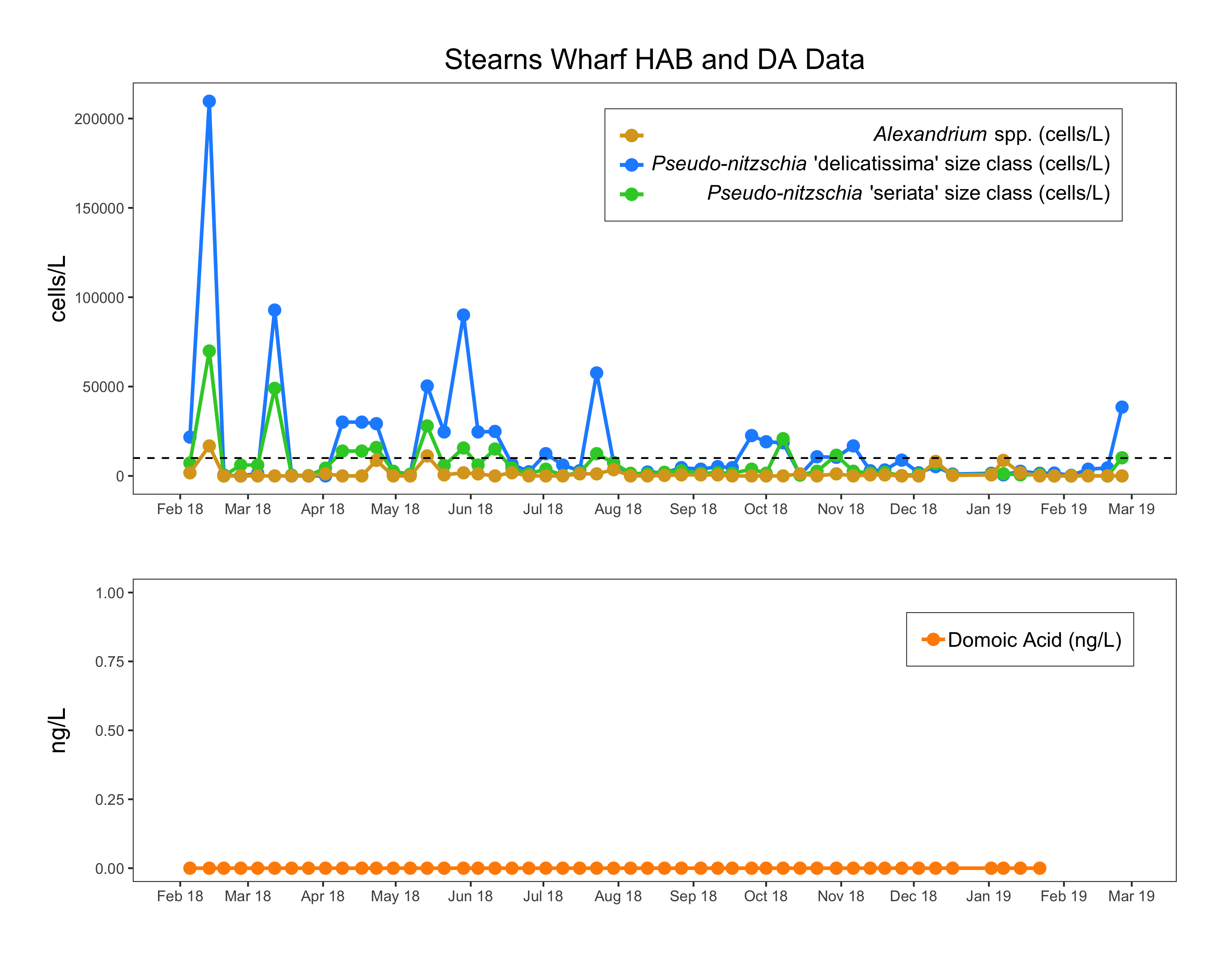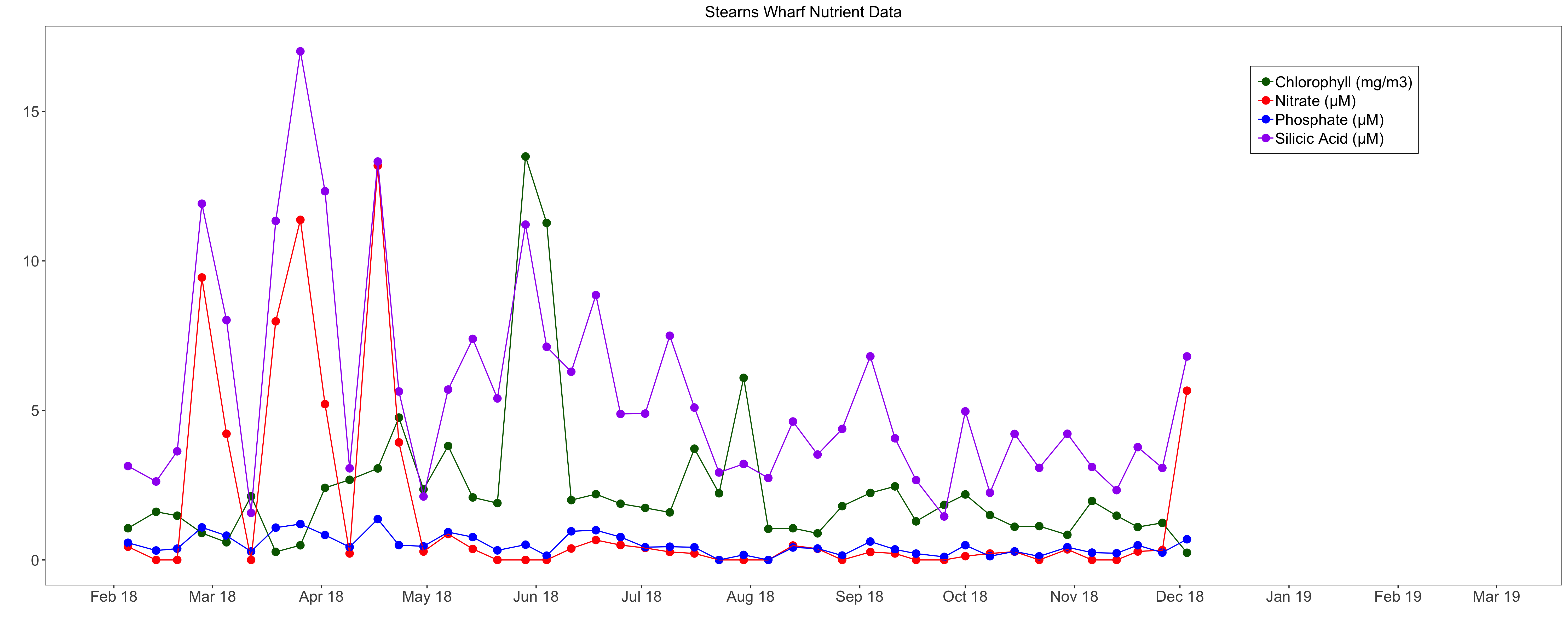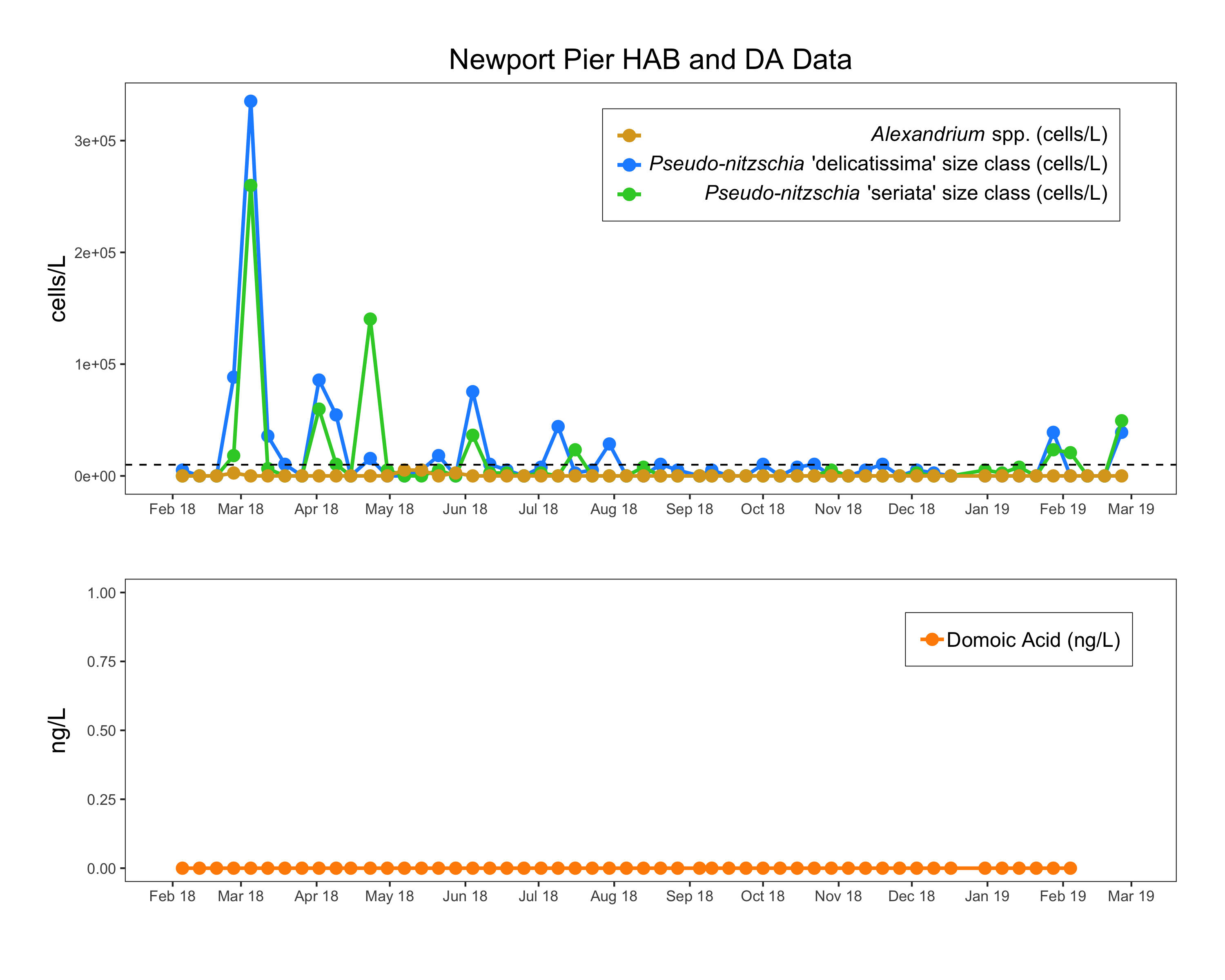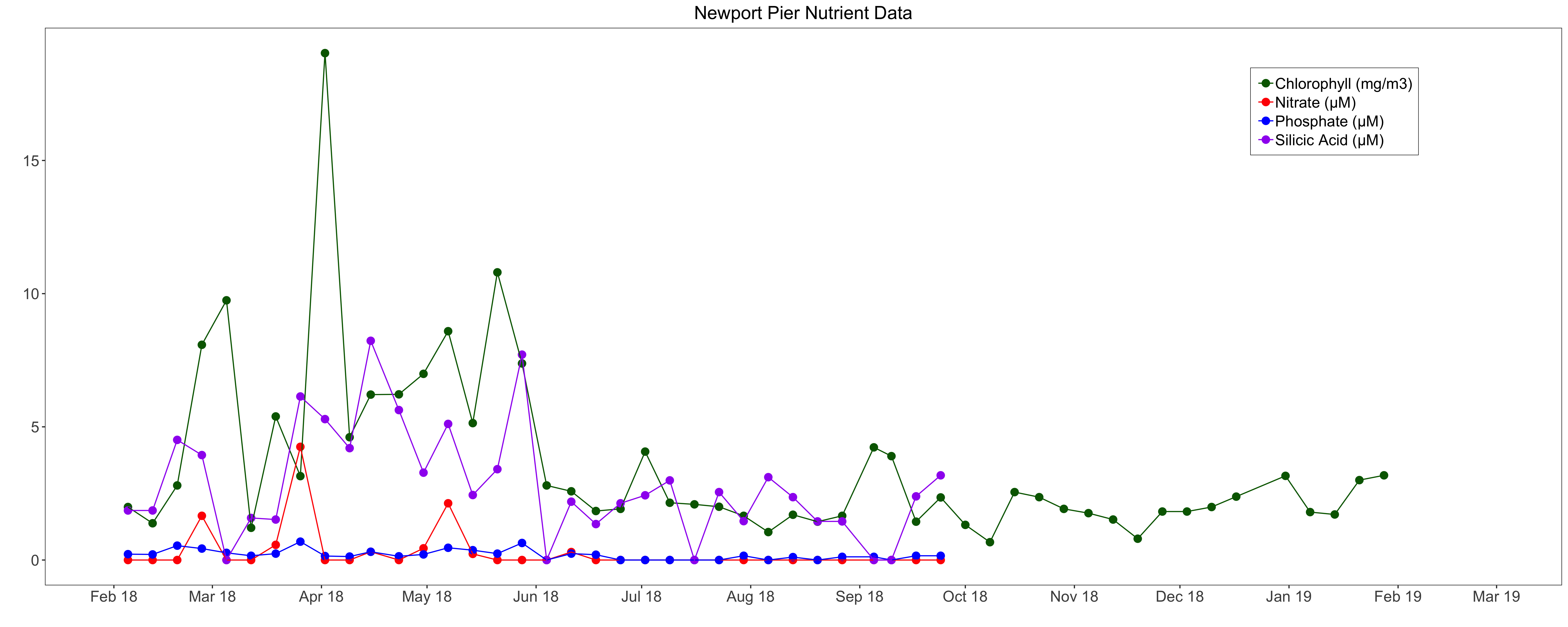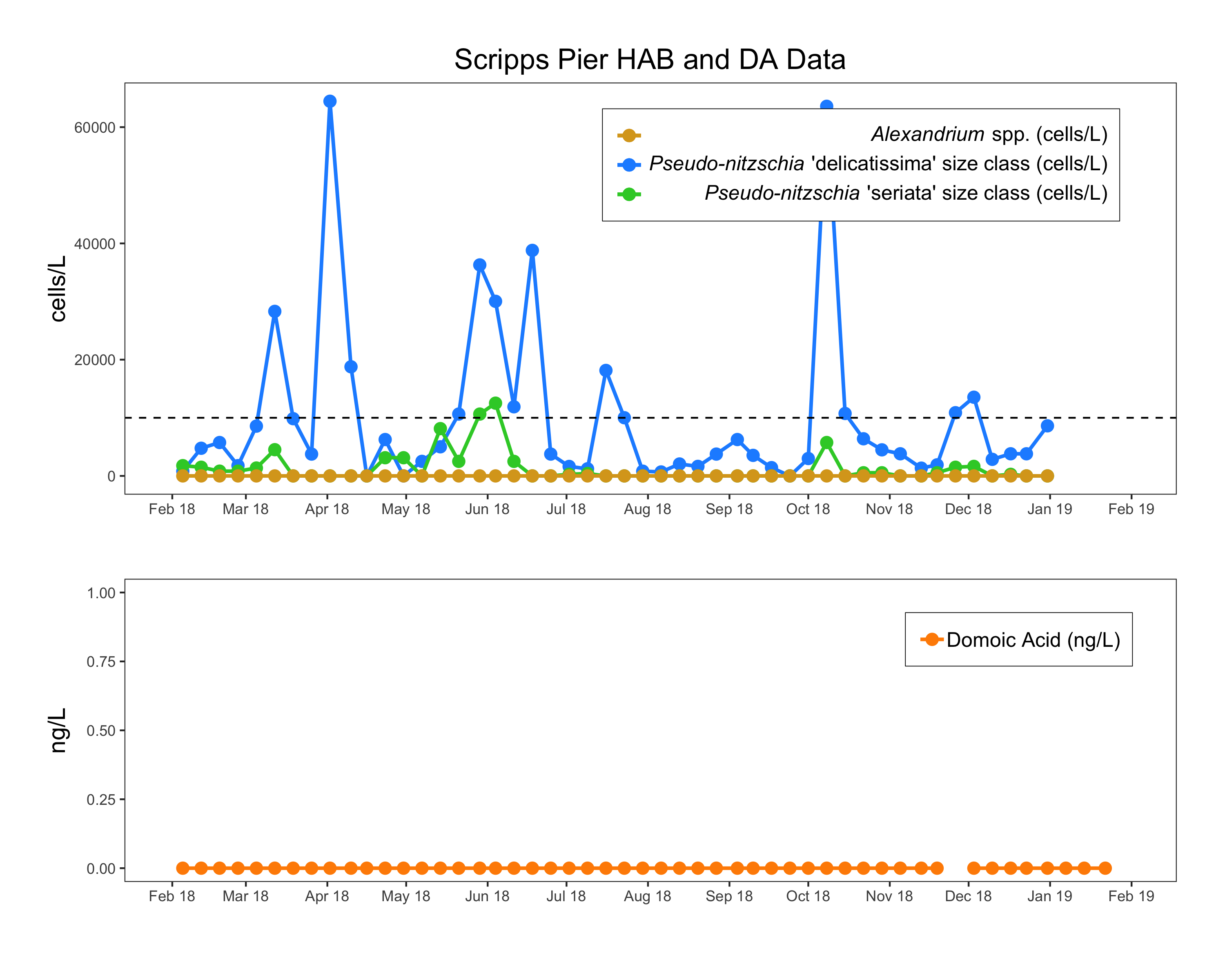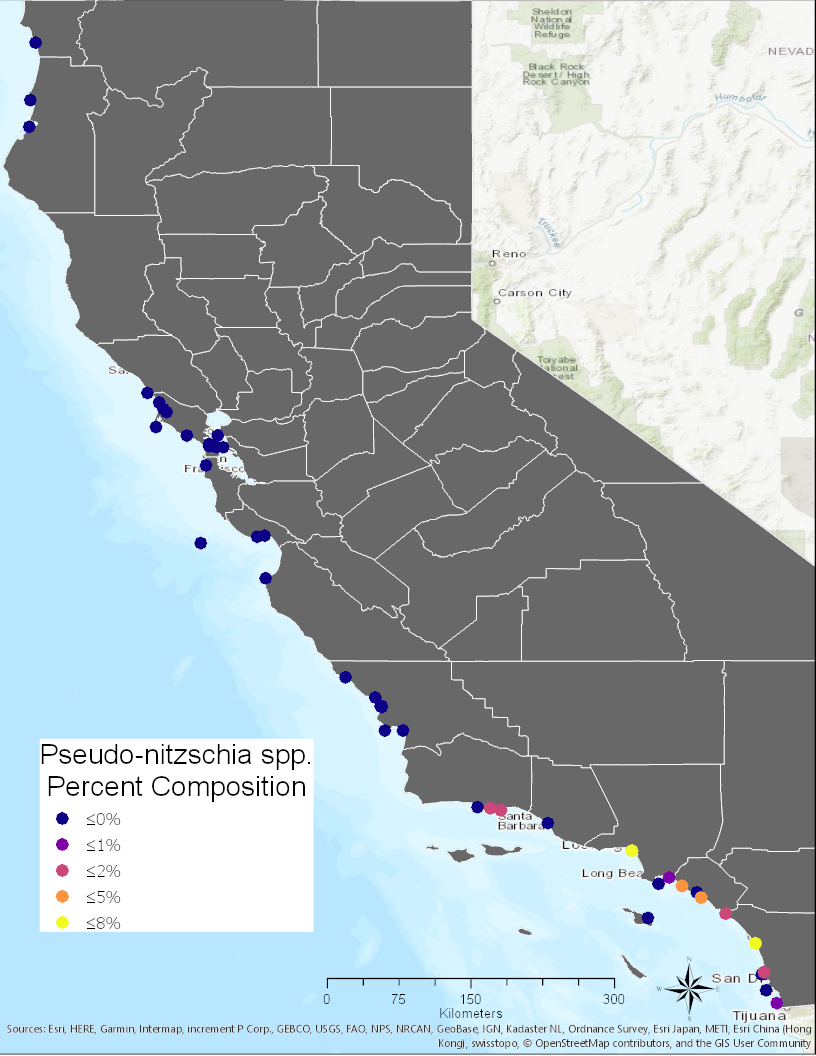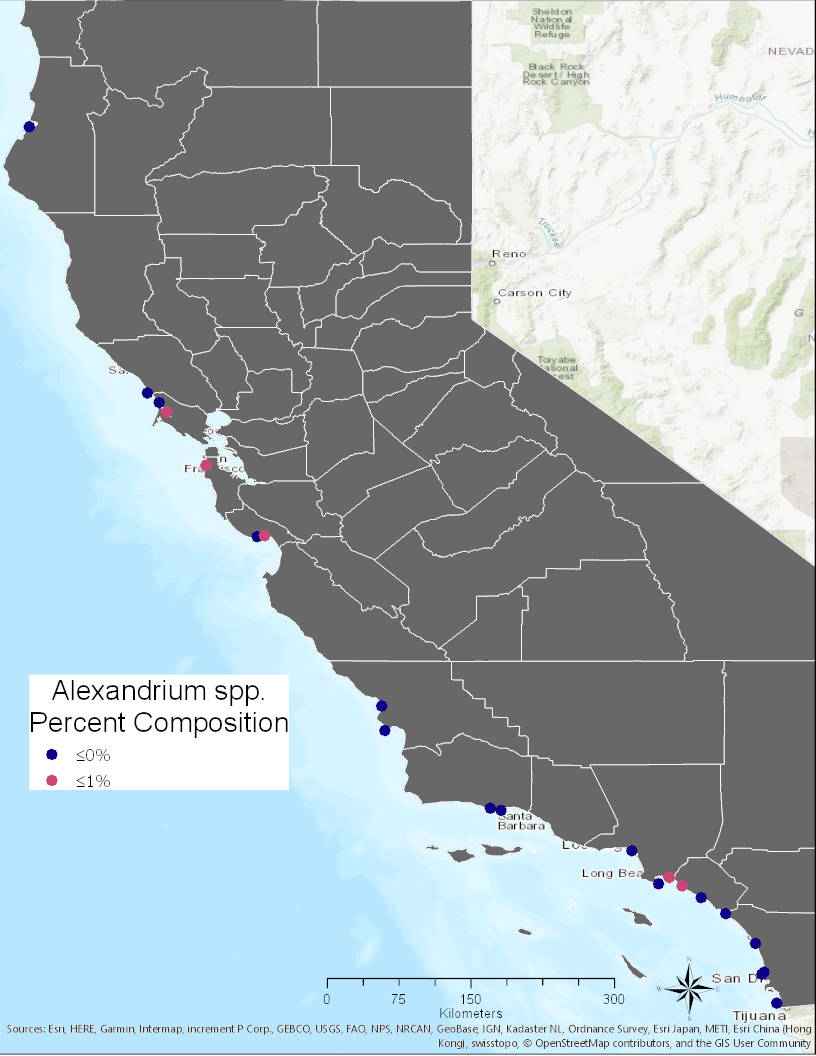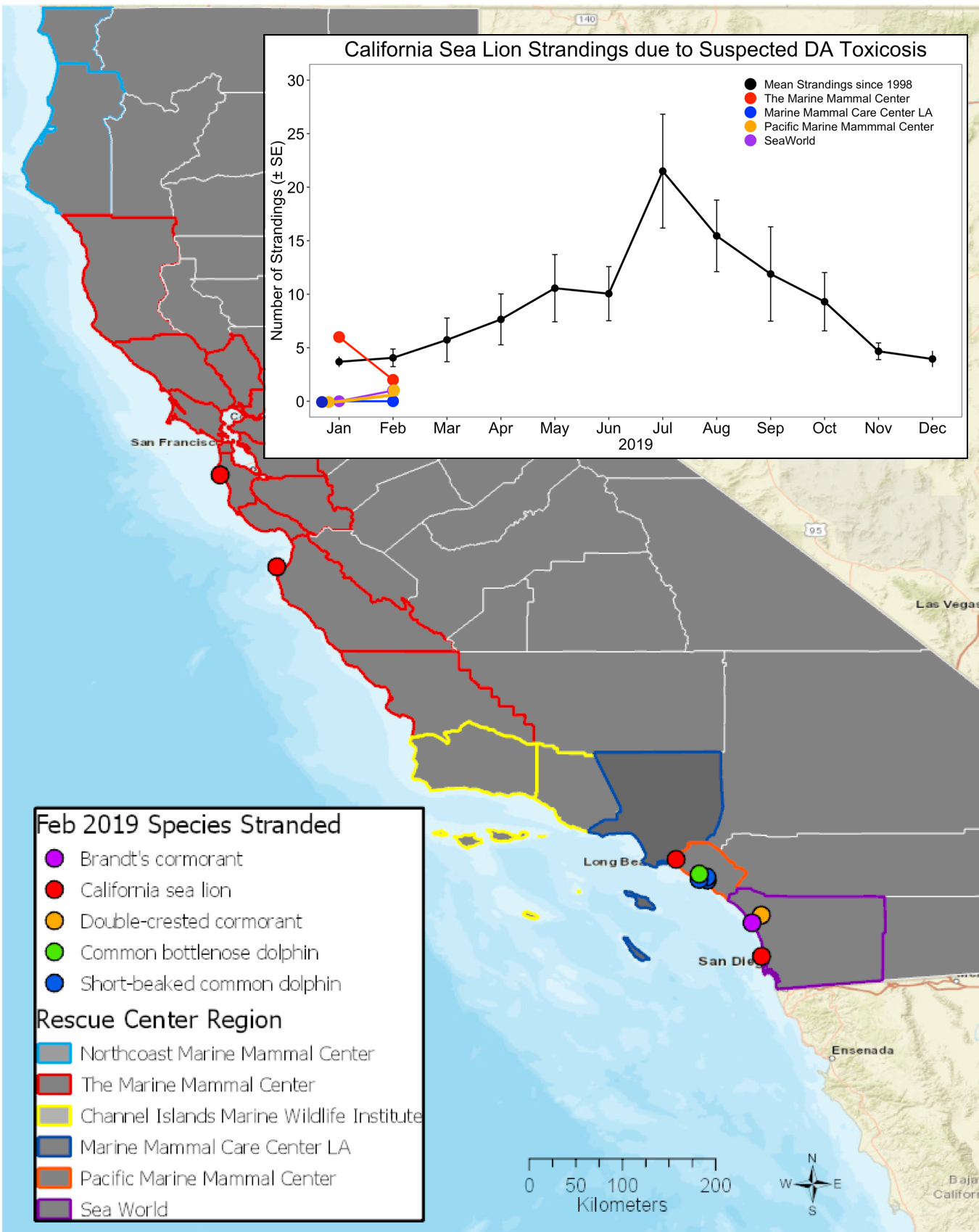Pseudo-nitzschia - C-HARM tells us where conditions are suitable for Pseudo-nitzschia spp. (all size classes) to grow well and where they might be more likely to produce domoic acid (DA). The monthly mean plot of C-HARM Pseudo-nitzschia bloom probability indicates higher likelihood of blooms in a fairly narrow band along the coast with broad patches of high probabilities offshore. Observed abundance of both "seriata" and "delicatissima" size classes spiked at the southern California HABMAP stations towards the end of February, particularly for the more toxigenic seriata group, in conjunction with an influx of stranded marine mammals and birds in the Orange and San Diego Counties. Mean C-HARM maps of the last week of February (not shown here) predict higher patches of offshore and even nearshore Pseudo-nitzschia bloom activity in those southern-most Southern California Bight regions, consistent with this up-tick in Pseudo-nitzschia biomass near pier sites. These observations are also consistent with an uptick in Pseudo-nitzschia spp. relative abundance CDPH sampling from LA to Orange County.
Domoic Acid - C-HARM also tells us where DA might be more likely to occur at high levels. Mean pDA likelihood mirrors the Pseudo-nitzschia bloom likelihood to some extent, with higher probabilities near the coast, although pDA was predicted to be even more likely in the Southern California Bight offshore waters than for Pseudo-nitzschia in those offshore, southern-most regions. Mean cDA was somewhat inverted from pDA, with very low nearshore probabilities and some enhanced activity in the southern-most SCB that is consistent what was described for the last week of Februrary for C-HARM Pseudo-nitzschia maps. This may indicate rapid growth of Pseudo-nitzschia in the region and high cDA production rates. It is too soon to know if this is the central cause of the seemingly DA-related marine mammal and seabird strandings recorded by PMMC and SeaWorld, but it is highly suggestive of a HAB connection. PMMC says they are seeing three times the stranding levels from the same time in 2018. We do not yet have the observed DA records from those HABMAP stations with which to compare the phytoplankton cell counts. In contrast, TMMC in Sausalito observed a decrease in marine mammal strandings from DA-toxicosis since January. It should be noted that the Dungeness crab commercial fleet is being required to terminate operations early this year (by April 15) to reduce spring-time interaction with whale populations feeding in the nearshore environment.
Alexandrium - HABMAP records for Alexandrium at pier sites show no activity from January to February 2019, which is consistent to little or no increases in the relative abundance of this dinoflagellate as measured by the CDPH volunteer phytoplankton monitoring network.
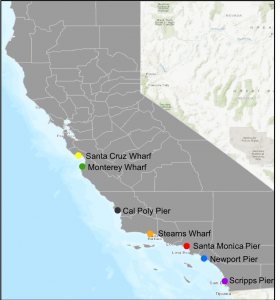
Note that data for some stations are not shown because they are not yet recorded in the public HABMAP archive.
Differentiating Pseudo-nitzschia species by light microscopy is difficult. For this reason, Pseudo-nitzschia "seriata" does not refer to an actual species but rather the larger size class of Pseudo-nitzschia, which is generally a more toxigenic group of species. Alternatively, Pseudo-nitzschia "delicatissima" refers to the smaller size class that is generally non-toxigenic. The dashed line on the plots demarcates the 10,000 cells/L "bloom" threshold designated here for Pseudo-nitzschia populations only.
Santa Cruz Municipal Wharf
Cal Poly Pier
Stearns Wharf
Santa Monica Pier
Newport Beach Pier
Scripps Pier
CDPH observations for Pseudo-nitzschia spp. and Alexandrium spp.
From 1-28 February 2019, water samples were collected by volunteers and sent to the California Department of Public Health (CDPH) for analysis. Pseudo-nitzschia spp. were detected in 26 of the 74 samples. Percent composition of Pseudo-nitzschia spp. was greatest on February 26th at Agua Hedionda Lagoon (8% composition) and on February 11th at Santa Monica Pier (7% composition). Alexandrium spp. were detected in low levels (<0.5% composition) in 5 of the 27 samples on February 8th, 10th, and 18th. You can also view CDPH weekly map layers of Pseudo-nitzschia and Alexandrium here.
The California Department of Fish and Wildlife (CDFW) issued no health advisories due to domoic acid in the month of February.
For the latest closures and updates, please visit the CDFW Health Advisories page. Data are provided by the California Department of Public Health, Environmental Management Branch.
California Marine Mammal and Seabird Strandings from DA Toxicosis
Domoic acid (DA) is a potent neurotoxin produced by some diatom species of the genus Pseudo-nitzschia. Species exposed to DA can result in seizures, epilepsy, cardiomyopathy, and death depending upon the ingested dose. DA toxicosis commonly occurs in California Sea Lions (Zalophus Californianus), presumably due to a combination of foraging behavior and seasonal movements. The Marine Mammal Center (TMMC), the Marine Mammal Care Center Los Angeles (MMCC-LA), the Pacific Marine Mammal Center (PMMC), and SeaWorld act like an emergency room by working to rescue and rehabilitate sick and injured marine mammals, seabirds, and sea turtles.
The Marine Mammal Center, The Pacific Marine Mammal Center, and SeaWorld recorded a total of 10 marine mammals and 2 seabirds strandings presented with symptoms of domoic acid toxicosis in the month of February.
No DA toxicosis cases have been reported by the Marine Mammal Care Center Los Angeles in February 2019.
February marine mammal and seabird strandings suspected due to DA toxicosis occurred at the following locations:
- February 2nd, 2019 - California Sea Lion stranded at Sawmill Gulch, Pebble Beach, Monterey County - TMMC
- February 11th, 2019 - California Sea Lion stranded at Pillar-Point, Princeton by the Sea, San Meteo County - TMMC
- February 11th, 2019 - California Sea Lion stranded at Seal Beach, Orange County - PMMC
- February 19th, 2019 - Short-beacked common dolphin - PMMC
- February 27th, 2019 - Double-crested cormorant - SeaWorld
- February 27th, 2019 - California Sea Lion - SeaWorld
- February 28th, 2019 - Brandt’s cormorant - SeaWorld
Who to call if you find a LIVE stranded marine mammal or sea turtle
Sea World of California (800) 541-7325
- San Diego County
Pacific Marine Mammal Center (949) 494-3050
- Orange County
Marine Animal Rescue (800) 399-4253 and California Wildlife Center (310) 458-9453
- Los Angeles County
Channel Islands Marine Wildlife Institute (805) 567-1505
- Santa Barbara County
- Ventura County
The Marine Mammal Center (415) 289-7325
- Alameda County
- Contra Costa County
- Marin County
- Mendocino County
- Monterey County
- Napa County
- Sacramento County
- San Francisco County
- San Luis Obispo
- San Mateo County
- Santa Cruz County
- Sonoma County
Northcoast Marine Mammal Center (707) 951-4722
- Del Norte County
- Humboldt County
